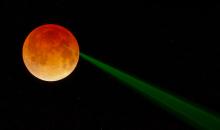Listen to today's episode of StarDate on the web the same day it airs in high-quality streaming audio without any extra ads or announcements. Choose a $8 one-month pass, or listen every day for a year for just $30.
You are here
Navi
Gamma Cassiopeia is a busy star system. The main star is surrounding itself with a disk of gas and dust. The star is interacting with an invisible companion. And it’s building up to an impressive demise.
Gamma Cass is the middle point of the letter M or W formed by the stars of Cassiopeia, which is high in the northern sky at nightfall. Gamma Cass is the most distant member of that pattern, at 550 light-years. The main star — the one visible to the eye alone — is between 15 and 20 times the mass of the Sun. And it’s about 35,000 times brighter than the Sun.
The star spins at about a million miles an hour at its equator. That causes it to bulge outward, so it’s shaped more like a lozenge than a ball. That high speed causes the star to fling gas from its surface, forming a disk around the star.
Its companion probably is the corpse of a once-mighty star. Some of the gas from the main star may fall onto this dead companion. As it does so it heats up and produces X-rays.
Gamma Cas is only about eight million years old, yet it’s nearing its end. In a few million years more, it’s likely to explode as a supernova — ending the life of this busy star.
Incidentally, Gamma Cas has a nickname: Navi. It was bestowed in the 1960s by the crew of Apollo 1. It’s the middle name of commander Virgil Ivan Grissom spelled backward. After the crew died in a launchpad fire, NASA placed Navi on the starcharts used by later crews to navigate to the Moon.
Script by Damond Benningfield





